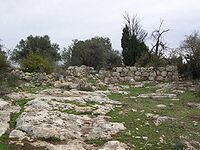Arabic خروبة Palestine grid 146/146 Date of depopulation July 12–15, 1948 | Population 170 (1945) | |
 | ||
Name meaning The carob, or locust tree Ceratonia siliqua | ||
Kharruba was a Palestinian Arab village in the Ramle Subdistrict of Mandatory Palestine, near Modi'in. It was located 8 km east of Ramla. It was depopulated on July 12, 1948 during the 1948 Arab–Israeli War.
Contents
History
Kharruba appeared in Ottoman tax registers compiled in 1596 under the name of Harnuba, in the Nahiyas of Ramla, of the Gaza Sanjak. It was indicated as empty (hali), though 25% taxes were paid on agricultural products. These included wheat, barley, summer crops, vineyards, fruit trees, sesame, goats, beehives, in an addition to occasional revenues; a total of 4,000 akçe.
In 1863, Victor Guérin described Kharruba as a hamlet of a few huts. He noticed the remains of a medieval fort and suggested it might be the Crusader castle Arnaldi. The following decade, the Survey of Western Palestine found only ruins.
British Mandate era
At the time of the 1931 census, Kharruba had 21 occupied houses and a population of 119 inhabitants, all Muslims. In 1945, the village had a population of 170, all Muslims. The total land area was3,374 dunams, of this, a total of 1,620 dunums were used for cereals, 25 dunums were irrigated or used for orchards, while 3 dunams were classified as built-up public areas.
1948, aftermath
It was depopulated during the 1948 Arab–Israeli War on July 12, 1948 by the Yiftach Brigade which reported that it had blown up the houses and "cleared the village".
In 1992, the site consisted of stony rubble overgrown with vegetation.
Archaeology
A site called Haruba is mentioned in the Copper Scroll, the only one of the Dead Sea Scrolls engraved on copper rather than written on parchment. Modern scholars do not believe it to be the site mentioned in the scroll.
In 2012, five suspected antiquities robbers were caught at Kharruba, after damaging a mikveh (ritual bath) dating to the Second Temple period and trenches used as hiding places during the Bar Kokhba revolt.
